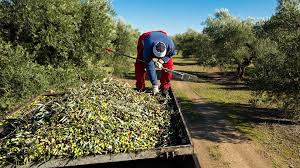Italy: Olive oil sector demonstrates resilience in new report

Paolo DeAndreis
Rome: Italian olive oil production is declining, with the 2024/25 crop year ending with 250,000 metric tons. Ismea reports a decrease in per capita olive oil consumption in Italy in 2024, with a shift towards cheaper options impacting the market. Despite challenges, Italian olive oil exports grew in 2024, and the sector is supported by various measures to adapt to changing conditions and increase production volumes.
The 2024/25 crop year is closing with 250,000 metric tons of production, as Italy’s olive oil yields continue to fall — averaging nine percent lower this decade compared to the last.
The latest figures released by Ismea, the public agency for services to the agricultural market, also confirmed that Italian per capita olive oil consumption declined in 2024, signaling a changing approach of many households to the staple product.
The Ismea report shows olive oil consumption decreasing in 2024 to 440,804 tons, compared with the 474,405 tons reported in 2023 and the 518,694 tons in 2022.
The data show that the average Italian consumes about 7.5 liters of olive oil per annum. In 2019, per capita consumption reached 7.6 liters. Seven years before, consumption was at 12 liters per capita.
“Consumers often do not know the difference between one product and the other,” Anna Cane, president of the olive oil group at the Italian Association of the Edible Oil Industry (Assitol), told Olive Oil Times.
“Consumers tend to value sustainability or quality, but when those mean more expensive choices, most of them go for the cheaper option,” she added, hinting at the need for the whole sector to better promote the unique qualities of extra virgin olive oil among Italian consumers.
In the first months of 2025, Ismea is reporting a growth of cheaper olive oil sales across the large food retailers, where discounts and special offers often dominate the scene.
In this context, extra virgin olive oil sales are growing 24 percent in the first months of 2025 compared to the same period of 2024.
The report highlighted how olive oil consumption in Italy has historically been much larger than production.
Together with the needs of large Italian exporters, this difference is one of the drivers behind the increase in olive oil imports in Italy.
Imports reached 446,000 tons in 2024, 2.3 percent more than the previous year. Their value was €3.131 billion, 28 percent more than in 2023.
From January to April, imports grew 66 percent compared to the same period of 2024, exceeding 250,000 tons.
Interestingly, their value dropped 13 percent over the previous year as the international listings for olive oil also declined considerably.
According to Ismea, Italian olive oil producers are showing significant resilience despite recent challenges facing the sector.
Italian olive oil exports in 2024 grew by 6.8 percent to 344,000 tons with a value exceeding €3.09 billion, 43 percent more than in 2023.
Data for the start of 2025 follow a similar trend: extra virgin olive oil sales from January to April 2025 reached 108,671 tons, 26 percent more than in the same period of 2024. Value decreased by 5.4 percent due to lower prices on the international markets.
In 2024, olive oil exports represented 4.5 percent of Italy’s total food exports.
According to Ismea, the sector’s resilience is also confirmed by several significant indicators.
Across the country, there are currently 620,000 registered companies involved in olive oil production, with more than 4,200 active olive oil mills. There have not been significant variations in most of the country in recent years.
“[The production drop] is linked to climate factors and alternate fruit-bearing seasons, but signs of recovery can already be seen,” the report’s authors wrote.
Fifty-eight percent of Italian olive farms manage less than three hectares, with only 17 percent conducting groves between ten and 200 hectares.
Interestingly, the report signals a growing trend of olive orchard sizes in northern Italy. In contrast, the south of the country remains by far the most significant in terms of hectares and yields.
Ismea noted how in Piedmont between 2020 and 2024, olive farms expanded their surfaces by 40 percent. Sixteen percent is reported for Friuli-Venezia Giulia and ten percent for other northern regions.
In southern Italy, the number of olive groves fell by six percent in Campania and five percent in Puglia. Only Sicily increased olive cultivation, with the number of hectares rising by 20 percent.
Quality and the value of unique terroirs are increasingly drivers for Italian producers: extra virgin olive oil registered under a geographical indication represented five percent of the Italian olive oil offerings in 2024, consolidating a growing trend in recent years.
“Italian olive oil is a symbol of quality, culture and identity. Performance in international markets confirms the sector’s ability to generate value and adapt, while maintaining a strong connection to the land and looking with confidence toward new challenges,” Sergio Marchi, Ismea director general, said while presenting the report.
Indeed, the report highlights the growing role played by organic olive farming in Italy.
In 2024, 15 percent of the overall olive oil production was organic, coming from 279,000 hectares of organic olive groves and representing 24 percent of the country’s total olive-growing area, which is increasing annually.
The southern regions of Puglia, Calabria and Sicily, Italy’s most relevant olive growing areas, are home to 72 percent of organic olive cultivation.
Ismea noted how to adapt to the changing climate and face the decline in yields, several measures already support the sector.
The agency listed the €34.6 million fund provided by the strategic plan for the Common Agricultural Policy (CAP) 2023 – 2027, the €100 million directed to olive oil mill renovation, €30 million to cope with Xylella fastidiosa and other incentives and quality improvement funds related to the CAP.
“A strategic package that supports the sector in its transition toward innovative, sustainable, value‑oriented production models, with the goal of recovering new production volumes,” the report authors concluded.





